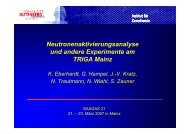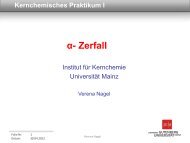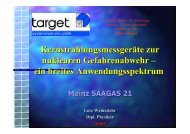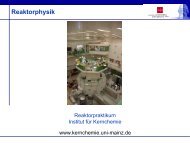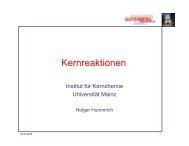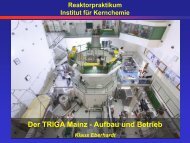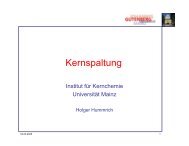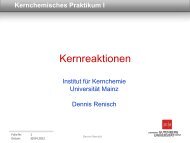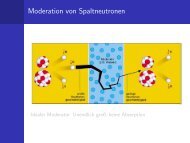jahresbericht 2007 - Institut für Kernchemie - Johannes Gutenberg ...
jahresbericht 2007 - Institut für Kernchemie - Johannes Gutenberg ...
jahresbericht 2007 - Institut für Kernchemie - Johannes Gutenberg ...
You also want an ePaper? Increase the reach of your titles
YUMPU automatically turns print PDFs into web optimized ePapers that Google loves.
Comparative study of 68 Ga-NOTA-radiolabelling<br />
in water, citrate and HEPES-buffer as reaction media<br />
Alejandro Amor Coarasa 2 ; Riss, Patrick 1 , Kroll, Carsten 1 ; Roesch, Frank 1<br />
1 <strong>Institut</strong>e of Nuclear Chemistry, Mainz University, Fritz Strassmann-Weg 2, 55128 Mainz; Germany<br />
2 IAEA-fellow, <strong>Institut</strong>o Superior de Tecnologias y Ciencias Aplicadas (InSTEC), La Habana, Cuba<br />
Introduction: The radiosynthesis of 68 Ga-labelled<br />
NOTA complexes is strongly dependent on the pHvalue<br />
of the reaction medium. The final pH-value<br />
obtained from ion-exchanger purified n.c.a. 68 Ga thus is<br />
strongly dependent on the volume of the N2-solution [1]<br />
For this reason, a buffer system, capable of tolerating<br />
different amounts of ion-exchanger purified<br />
68 Ga<br />
solution without affecting the radiochemical yield<br />
would be beneficial for optimisation studies. In the<br />
present study, the adequacy of citrate and HEPES-buffer<br />
as reaction media is examined.<br />
Materials and Methods: A 1 mg/ml stock solution of<br />
NOTA was prepared in Millipore water. This solution<br />
was used in all experiments. Experiments were carried<br />
out adding the 400 µl elution from the generator to 5 mL<br />
of reaction buffer (pH=3,7) or water. After preheating<br />
the sample for 10 minutes, a defined volume of NOTA<br />
stock solution was added subsequently. The volumes<br />
used were 1, 5 and 20 µl at 60 °C of temperature.<br />
Samples were taken at 1, 2 5 10 minutes of reaction,<br />
placed on a silica TLC and run in two different solvents:<br />
NaCl 5% and Citrate buffer (pH=4). Every experiment<br />
was made triplicate.<br />
Figure 1: [ 68 Ga]HEPES-complex on radio-TLC<br />
% Yield<br />
NOTA + HEPES<br />
100<br />
90<br />
80<br />
70<br />
60<br />
50<br />
40<br />
30<br />
20<br />
10<br />
1 60 °C<br />
5 60 °C<br />
20 60 °C<br />
1 75 °C<br />
5 75 °C<br />
20 75 °C<br />
Results and Discussion: Labeling yields are very<br />
variable in water and HEPES (up to 30 % variability). It<br />
is supposed that the NOTA labeling should go well in<br />
HEPES buffer because it has the right labeling pH value<br />
and it is used commonly to chelate DOTA and DOTA-<br />
X pharmaceuticals. Nevertheless, at this reaction<br />
temperature it seams like the HEPES buffer interfere in<br />
the labeling reaction depending on the heating time. It<br />
was found, that HEPES buffer forms a complex with<br />
68 Ga. Although it is a slow reaction, the vessels in the<br />
previous experiments were prepared with HEPES +<br />
68 Ga and then preheated for 10 minutes before adding<br />
NOTA. It is important also to consider concentrations,<br />
HEPES is very concentrated while NOTA is only a few<br />
µg. The 0.5 mL HEPES system shows better results, but<br />
once the elution is added to the solution pH goes to<br />
2.22. This is not the right labeling pH, so the decision<br />
was continue with HEPES buffer to obtain the complete<br />
data labeling for NOTA in 60 and 75 °C using 1, 5 and<br />
20 µg of NOTA but changing experiments a little bit to<br />
reduce HEPES effect.<br />
0<br />
0 2 4 6 8 10 12<br />
Time (min)<br />
Figure 2: Data set for NOTA chelating in HEPES buffer at 60<br />
and 75 °C for 1, 5 and 20 NOTA µg<br />
Better results are achieved with these experiments up to<br />
90 % labeling using 20 µg at 75 °C temperature.<br />
Nevertheless are lower that those reported for the<br />
NOTA + water system.<br />
Figure 3. HEPES buffer interference for 1 µg NOTA at 60 °C<br />
in NaCl 5%<br />
Conclusion: Even when precautions are taken to reduce<br />
the HEPES influence, its concentration in solution is<br />
very large and competes with NOTA in the labeling<br />
process. It is important so say that its influence can only<br />
be demonstrate using the NaCl 5% chamber.<br />
- B13 -<br />
References:<br />
[1] Zhernosekov, K.P. , Rösch, F. et al. J Nucl Med., 48(10):<br />
1741-8, <strong>2007</strong>



